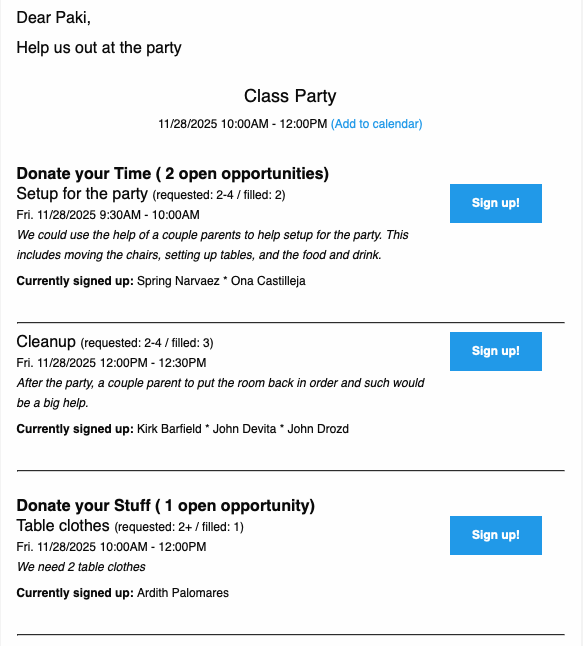Building a Culture of Volunteerism at Your School: Start Small, Grow Strong

If you’ve ever led a PTA or PTO, you know the feeling: you put out a call for volunteers for a big event… and the response is crickets. It’s tempting to conclude that parents just aren’t willing to help.
The truth is simpler — and more optimistic: you can’t go from 0 to 100. A strong volunteer culture isn’t built through one big ask. It’s built through small, regular opportunities that help parents feel connected, confident, and comfortable participating.
Think of it like building a muscle: consistency beats intensity.
Why Parents Don’t Volunteer (Yet)
For many families, volunteering at school can feel intimidating:
- I don’t know anyone.
- I’m not sure what I’m supposed to do.
- I don’t want to get stuck with a huge responsibility.
- I’m already overwhelmed — what if this is one more big commitment?
A culture of volunteerism dissolves these concerns over time — but only if you invite parents in gradually, with clear, low-pressure ways to help.
Start Small: Weekly Micro-Opportunities
Most schools aim too high on their first try. Instead of starting with a giant volunteer day, begin by creating simple, predictable ways to help, such as:
- A weekly library re-shelving shift.
- Two parents reading to children on Friday mornings, giving teachers a brief break.
- Parents monitoring recess or the lunchroom alongside staff.
- Helping with morning drop-off or afternoon dismissal.
- Tidying the art room, organizing the lost-and-found, or prepping materials.
These small roles do two powerful things:
- They build confidence. Parents feel comfortable volunteering when they know exactly what they’re walking into and the time commitment is clear.
- They build community. When parents show up regularly, they get to know staff, other parents, and the rhythm of the school.
Over time, those familiar faces and simple tasks lay the groundwork for bigger, one-time events that no longer feel like such a lift.
Use Pairs, Not Individuals
One simple tweak can significantly boost participation: ask parents to volunteer in pairs.
People are more willing to try something new if they can do it with a friend. When your PTA or PTO frames opportunities as bring a buddy, you reduce social anxiety and make the experience feel more fun and less formal.
In your sign-up forms and communication, try language like:
- “Sign up with a friend — we love volunteer pairs!”
- “Grab another parent you know and take a recess shift together.”
- “New to the school? We’ll pair you with a returning parent.”
Partnering With School Administrators
Parent organizations shouldn’t have to guess where help is needed. The best volunteer cultures happen when PTAs, PTOs, and school administrators work as a team.
Parent leaders can ask administrators:
- “What’s draining staff time right now that isn’t directly instructional?”
- “Is there a task parents could take off teachers’ plates?”
- “Can we run a small pilot — for example, volunteers in the library for two weeks — and see how it goes?”
And administrators can respond with:
- “We could use help here, but we need it structured this way…”
- “Here’s what worked (and didn’t) in the past.”
- “Let’s start small, measure how it’s going, and adjust.”
When expectations are clear on both sides, parents feel trusted, staff feel supported, and students benefit from a more connected community.
Another Key: Make Volunteering Drop-Dead Simple
Even if parents want to help, they often hit tiny but very real barriers:
- “I can’t remember where to sign up.”
- “I saw the email, but I lost the link.”
- “I’m on my phone — I’ll do it later when I’m at my computer.”
- “I’m not sure who else is going. I don’t want to be the only one.”
One of the biggest drivers of volunteer success is removing these frictions. The more steps you require, the fewer sign-ups you will get. Even removing a single barrier can dramatically increase participation.
A few simple principles:
- Don’t make parents go hunt for sign-up links. Bring volunteer opportunities directly to them via email, text, or their parent app.
- Make sign-up mobile-friendly and one-click simple. If they can’t volunteer from their phone in a few seconds, many won’t.
- Show who else is signed up. Seeing familiar names helps parents feel more comfortable jumping in.
- Automate reminders. Life is busy; reminders close the gap between good intentions and real attendance.

A Note to School Administrators
For school leaders, managing parent volunteers can sometimes feel like more work than it’s worth — especially at the beginning. There’s coordination, communication, and some trial and error.
But once the culture is in place, the payoff can be huge:
- Teachers gain back time and energy.
- Parents feel seen, included, and valued.
- Students experience a stronger sense of community.
- Big events become far easier to staff.
- Fundraising and school initiatives benefit from higher engagement and trust.
Think of it as a short-term investment that compounds over time. Each small, positive volunteer experience makes the next “yes” easier.
Ready to Build Your Volunteer Culture With Less Work?
This is exactly where ClassroomParent comes in. Your volunteer strategy shouldn’t be held back by clunky spreadsheets and scattered sign-up links.
ClassroomParent helps PTAs, PTOs, and school leaders:
- Send volunteer opportunities directly to parents — no more hoping they remember to visit a site on their own.
- Make sign-ups drop-dead simple with mobile-friendly, one-click responses.
- Show who else has volunteered, so parents feel more comfortable joining in.
- Automate reminders so no one forgets their shift.
- Manage events, volunteers, and communication in one place instead of juggling multiple tools.
When you remove friction and make it easy for families to say “yes,” your culture of volunteerism grows faster — and with far less stress for the parent organization and the school.
Learn more about how ClassroomParent supports volunteers
Free Download: Volunteer Culture Starter Checklist
Want to turn this article into action at your school? Use this simple checklist as your first-year roadmap for building a culture of volunteerism.
Download the checklist as a PDF
Checklist Preview
Phase 1: Get Organized
- Define your volunteer goals for the year (e.g., “10 parents per month in micro-roles”).
- Identify 3–5 small, recurring volunteer opportunities (library, recess, reading, etc.).
- Meet with school administration to align on where parent help is most useful.
- Choose your core tools for communication and sign-ups (e.g., ClassroomParent).
Phase 2: Launch Micro-Opportunities
- Set clear descriptions, time commitments, and expectations for each role.
- Create sign-ups that are mobile-friendly and one-click simple.
- Encourage “bring-a-friend” or volunteer pairs in every communication.
- Start with a small pilot (4–6 weeks) and gather quick feedback from staff and parents.
Phase 3: Make It Easy to Say “Yes”
- Send volunteer opportunities directly to parents — don’t wait for them to go looking.
- Turn on automatic reminders so volunteers don’t forget shifts.
- Show who else is signed up to reduce anxiety for new volunteers.
- Thank volunteers publicly (with permission) in newsletters or group messages.
Phase 4: Grow and Celebrate
- Review what worked and what didn’t at the end of each quarter.
- Add one or two slightly larger opportunities once micro-volunteering is running smoothly.
- Ask teachers where additional help would be most appreciated.
- Celebrate milestones (e.g., “50 volunteer shifts filled this semester!”).
Key Takeaways
- You can’t go from 0 to 100 — big volunteer days require small habits first.
- Micro-volunteering builds confidence, relationships, and momentum.
- Volunteer pairs make it easier (and more fun) for parents to jump in.
- PTAs, PTOs, and administrators should co-design volunteer roles.
- Removing friction — with tools like ClassroomParent — can dramatically increase sign-ups.
- Once the culture is in place, the payoff for students, staff, and families is huge.